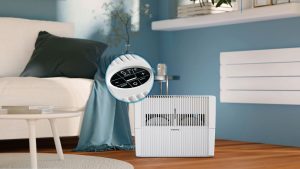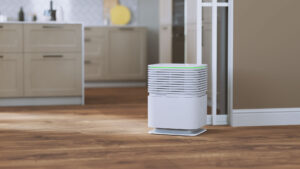If you live in a colder climate, you likely spend more time inside your cozy dwelling during the winter. Yet, drier air, indoor pollutants, and poor ventilation are enough to lower air quality, putting your household’s or business’s health at risk.
Humidifiers and Airwashers are prime solutions for improving breathing. Here’s how you can utilize these tools to improve air quality and transform your indoor environment.
How Bad Is Indoor Air Quality in the Winter?
The U.S. Environmental Protection Agency says Americans spend approximately 90% of their time inside, where air pollution is two to five times greater than outside. This increases health risks for older adults, children, and those with cardiovascular and respiratory conditions.
The most concerning indoor pollutants include particulate matter (PM2.5), carbon monoxide, and other combustion byproducts. Pet dander, mold, radon, lead, asbestos, and volatile organic compounds (VOCs) from paint, cleaners, and furniture are additional air contaminants.
Winter months are prime time for warming up next to a fire. However, you can increase the amount of PM2.5 in your house. According to one study, open fireplaces without outdoor air intake produce 62.2 milligrams of PM2.5 per kilogram (mg PM2.5/kg) of firewood. Utilizing these fireplaces for four hours daily can actually reduce your life expectancy by 1.6 years. Similarly, woodstoves emit up to 23.2 mg PM2.5/kg of wood.
It’s also common for humidity levels to decrease significantly when the weather becomes cold, causing dry skin, nosebleeds, breathing problems and allergens to remain airborne for much longer.
Therefore, ensuring good air quality is just as important for your overall health in winter as it is for maintaining comfort in indoor spaces. Ideally, you want to create a balance between cleaner air, optimal humidity and warmth to support your immune system and well-being.
Humidifiers and Winter Air Quality

You may not have realized it before, but humidity and indoor air quality go hand in hand. When humidity levels are too low, condensation and frost may appear on cold surfaces. Low humidity can worsen chemical pollutant concentrations, including VOCs, ozone and radon. In fact, some chemical interactions — like ozone — affect indoor air quality at 30% or below.
Venta Humidifiers maintain optimal humidity between 40-60%. This allows for comfortable indoor air while preventing mold growth. Relative humidity is vital for your health, work performance and reduced infection susceptibility — this is best achieved with a humidifier. Humidifiers increase ambient moisture by releasing water vapor. In winter, water vapor reduces dryness, making it easier to breathe and creating a more comfortable living space.
Airwashers for Cleaner Air
An Airwasher doubles as a humidifier and purifier for cleaner indoor air. These mechanisms pull dry air in through a HEPA filter, run it through water and capture dust particles, bacteria and allergens. The Airwasher then pushes clean, vaporized air back into your living environment, helping maintain proper humidity levels during the colder months.
Many people prefer Airwashers for their convenience and low maintenance needs. Some key features to look for include high water capacity, a sufficient filtration system, and effective removal of air contaminants. Like some of our humidifiers, our Airwashers also come with built-in hygrometers and various settings.
Additional Tips for Improved Indoor Air Quality

There are several other ways to optimize indoor air quality through humidity control, air purification, cleaning habits, and thermostat settings. When utilizing humidifiers and Airwashers, be sure to maintain and clean them regularly by emptying the water tanks every 14 days and washing the surfaces to avoid mold growth. Additionally, you’ll want to replace their filters once a year when prompted.
Also, monitor indoor moisture levels. If indoor humidity is too high, it can stimulate more bacteria growth and allergens, further hurting your health and well-being.
Other things you can do to ensure a comfortable indoor environment during the winter months include:
- Open windows for ventilation when the weather permits.
- Purchase a portable air purifier you can transport from room to room to remove air contaminants and allergens — Venta Airwashers and air purifiers can remove 99.97% of invisible particles with its cutting-edge filtration technology.
- Bring air-purifying greenery into your home, such as spider plants, snake plants and aloe vera.
- Avoid using harsh cleaning supplies and other chemicals to reduce pollutants.
Finally, avoid starting a fire by programming your thermostat to a sufficient temperature. The U.S. Department of Energy recommends lowering your thermostat by 7-10 degrees Fahrenheit for eight hours daily from its usual setting. This means your thermostat should be between 68-70 degrees F during daytime hours and lower at night or when no occupants are home.
Hibernate this Winter With Better Air
You’ll likely be itching for spring’s arrival after months holed up inside your house or office during the colder season. Fortunately, there are ways to improve air quality while waiting for the perfect weather to arrive so you can open the windows. Consider installing humidifiers and Airwashers during the winter to keep your indoor air clean, healthy, and fresh.

